From Start to Finish: Simplifying the Process of Growing Plants in Containers
Gardening enthusiasts have long enjoyed the beauty and rewards of growing plants in containers. Whether you have limited space, lack a suitable outdoor garden area, or simply want to add greenery to your indoor spaces, container gardening provides an excellent solution. However, starting and maintaining a successful container garden may seem daunting for beginners. In this article, we will guide you through the process of growing plants in containers, simplifying each step from start to finish.
1. Choosing the Right Container:
The first step is selecting the appropriate container for your plants. Consider factors such as size, material, drainage, and aesthetic appeal. Choose a container with sufficient depth and width to accommodate the plant’s root system. Ensure that it has adequate drainage holes to prevent waterlogging.
2. Selecting Suitable Plants:
Next, choose plants that are well-suited for container gardening. Consider their sunlight requirements, growth habits, and size at maturity. Opt for compact varieties or those labeled as suitable for containers. Popular choices include herbs, vegetables like tomatoes or peppers, flowering annuals like petunias or marigolds, or even dwarf fruit trees.
3. Potting Mix:
Selecting a quality potting mix is essential for healthy plant growth in containers. Avoid using garden soil as it tends to be heavy and may not provide adequate drainage. Instead, opt for a well-draining commercial potting mix enriched with organic matter or compost.
4. Planting Process:
When planting your chosen plants in containers, fill them with the potting mix leaving sufficient space at the top to water adequately without overflowing during watering sessions. Gently remove the plant from its nursery pot and loosen any compacted roots before placing it carefully into its new home at a level where it was previously growing.
5. Watering Routine:
Establishing an appropriate watering routine is vital for container plants’ well-being. Regularly check the soil’s moisture level by inserting your finger about an inch deep into the soil. If it feels dry at this depth, it is time to water. Ensure thorough watering, allowing excess water to drain out of the container.
6. Fertilization:
Container plants need regular feeding since their growth is limited by the amount of available nutrients in their confined space. Use a balanced, water-soluble fertilizer and follow the manufacturer’s instructions for application rates and frequency. Avoid over-fertilization, as it can lead to nutrient burn and other issues.
7. Maintenance Tips:
To ensure healthy growth, routine maintenance is essential. Monitor plants for any signs of pests or diseases and promptly address them using organic or chemical remedies as appropriate. Regularly prune or deadhead spent flowers to encourage continuous blooming. Provide support structures like stakes or trellises for vining or climbing plants.
8. Rotating Sun Exposure:
Most plants benefit from receiving sunlight from all sides to promote balanced growth and prevent leaning towards a single light source. Periodically rotate your containers so that each side receives equal sunlight exposure.
9. Seasonal Changes:
Containers offer flexibility when it comes to adapting to seasonal changes. In colder regions, move containers indoors or to protected areas during winter months to prevent frost damage. Consider overwintering perennial container plants by providing them with proper insulation.
10. Harvesting and Enjoyment:
Finally, one of the most rewarding aspects of container gardening is being able to harvest and enjoy the fruits of your labor. Whether it’s freshly picked herbs for cooking, bright blooms adorning your patio, or homegrown vegetables on your plate – container gardening allows you to experience nature up close in a convenient way.
In conclusion, growing plants in containers doesn’t have to be complicated or intimidating with the right approach and knowledge at hand. By following these simplified steps from start to finish – choosing appropriate containers, selecting suitable plants, using quality potting mix, establishing a watering routine, fertilizing adequately, routine maintenance, sun exposure rotation, adapting to seasonal changes, and eventually harvesting and enjoying the rewards – you can embark on a successful container gardening journey. So grab your containers and let your green thumb thrive!














